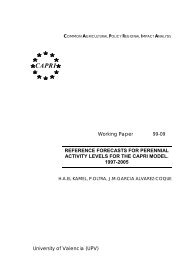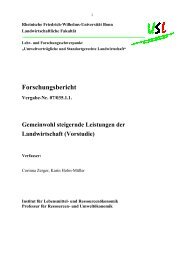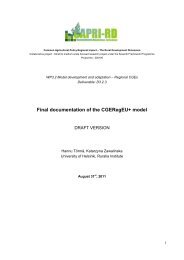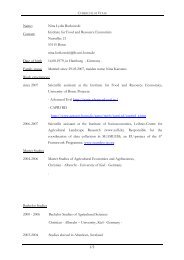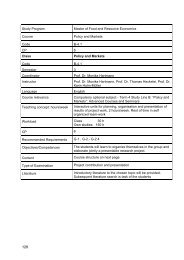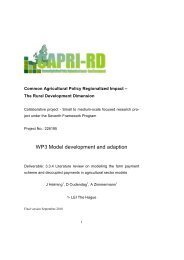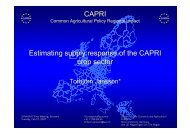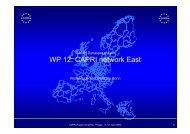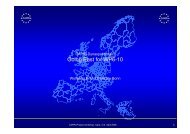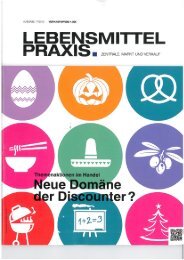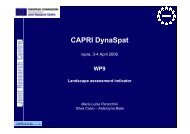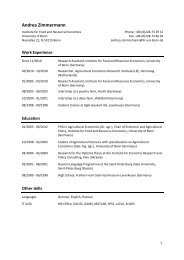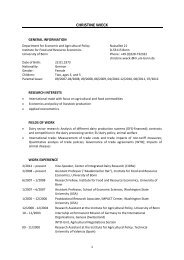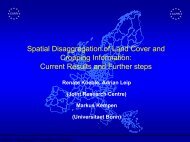Research proposal of sub-project B2 for second phase - Institut für ...
Research proposal of sub-project B2 for second phase - Institut für ...
Research proposal of sub-project B2 for second phase - Institut für ...
You also want an ePaper? Increase the reach of your titles
YUMPU automatically turns print PDFs into web optimized ePapers that Google loves.
FOR1501 – RCR (2)<br />
<strong>B2</strong>: Resilience <strong>of</strong> SES from a Resource Economics Perspective<br />
1. Which kind <strong>of</strong> institutional set-up is able to improve the ecological, social and socioecological<br />
resilience <strong>of</strong> the Thaba Nchu communal SESs?<br />
2. Is the Kuruman SES in a similar process <strong>of</strong> decoupling and does it exhibit low levels <strong>of</strong><br />
adaptive capacity similar to the Thaba Nchu SES?<br />
3. How do remittances from labor migration networks, local income opportunities, and biome<br />
types impact resilience on different SES dimensions?<br />
4. How do both dynamic systems respond when faced with droughts, cuts in state transfers,<br />
variability in food prices, and changing labor market conditions?<br />
2.3 Work program including proposed research methods<br />
Methods and work program Kenya: The purpose <strong>of</strong> hydro-economic modeling is to assess<br />
the resilience <strong>of</strong> the Lake Naivasha Basin SES towards meteorological shocks such as multiannual<br />
droughts. For that purpose, institutional scenarios will be combined with weather<br />
scenarios oriented toward extreme weather events <strong>of</strong> the past hundred years. Resilience will<br />
be assessed by looking at the persistence <strong>of</strong> water-based economic activities during drought.<br />
Simulations <strong>of</strong> the resilience <strong>of</strong> the Lake Naivasha SES will be carried out using the hydroeconomic<br />
model (LANA-HEBAMO) that was developed during the first <strong>project</strong> <strong>phase</strong> (Kuhn<br />
and van Oel 2012). Based on this is conceptual work, alternative mathematical optimization<br />
problem <strong>for</strong>mats will be investigated regarding their suitability to reflect institutional<br />
deficiencies in basin-wide water management. The mixed complementarity <strong>for</strong>mat (MCP, see<br />
Kuhn and Britz 2012) will be tested against ‘Multiple Optimization Problems with Equilibrium<br />
Constraints’ (MOPEC, see Ferris and Wets 2012). The use <strong>of</strong> both MCP and MOPEC in river<br />
basin models is completely new and highly innovative, enabling policy analysis under the<br />
assumption <strong>of</strong> imperfect institutions.<br />
MCP basically represents the first derivative <strong>of</strong> an optimization problem. Formulating an<br />
optimization problem as an MCP requires that local shadow price relations are explicitly<br />
included into the equation system (Ferris and Munson 2000). This facilitates the disruption <strong>of</strong><br />
local shadow price relations, as is the case in a river basin with water users that are not<br />
<strong>sub</strong>ject to institutional constraints (Kuhn and Britz 2012). An extensive literature review<br />
confirmed that the MCP <strong>for</strong>mat has not yet been used in river basin modeling. Thus, the<br />
potential <strong>for</strong> MCP to represent and address problems where local externalities exist (such as<br />
in upstream-downstream settings) has hardly been explored <strong>for</strong> resource modeling or related<br />
economic investigations.<br />
The downside <strong>of</strong> MCP is that the differentiation <strong>of</strong> nonlinear models, with respect to the<br />
numerous decision variables, <strong>of</strong>ten results in very complex first-order conditions (Heidecke,<br />
Kuhn and Klose 2008). A new, alternative problem <strong>for</strong>mat that avoids this cumbersome<br />
process is MOPEC (Multiple Optimization Problems with Equilibrium Constraints). Recent<br />
work has developed new extensions to the GAMS modeling language (General Algebraic<br />
Modeling System, Brooke et.al. 2010), to facilitate the <strong>for</strong>mulation <strong>of</strong> MOPEC problems as a<br />
special case <strong>of</strong> the Extended Mathematical Programming (EMP) framework (Ferris et al.<br />
2009).<br />
GAMS EMP provides an automatic trans<strong>for</strong>mation <strong>of</strong> a MOPEC into an MCP by explicitly<br />
A. Proposal Data and Obligations / Daten zum Antrag und Verpflichtungen 15



